![]()
Wed, April 18, 2012 | This study[1] is originally published by The Meir Amit Intelligence and Terrorism Information Center
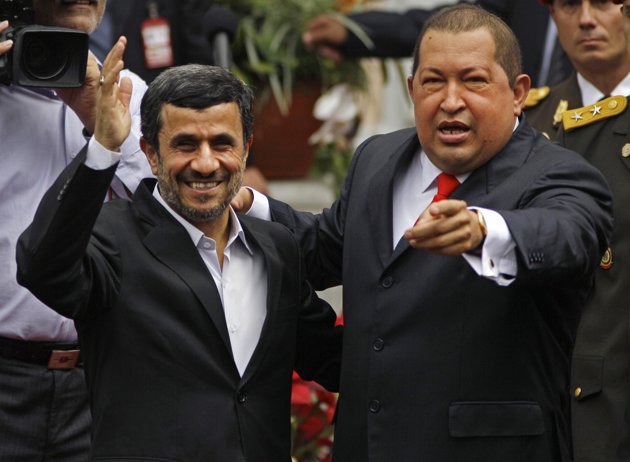
Iran's President Mahmoud Ahmadinejad, left, is received by Venezuela's President Hugo Chavez at the Miraflores presidential palace in Caracas, Venezuela, Monday Jan. 9, 2012. (Photo By Ariana Cubillos/AP)
Overview
Background Information
Since Ahmadinejad was elected president in August 2005, Iran has extended and solidified its relations with several Latin American countries, especially Venezuela and Bolivia, and increased its efforts to obtain a political foothold in the others. According to findings brought before the American Senate Foreign Relations Committee, Iran has significantly increased its diplomatic representation in Venezuela, Bolivia, Nicaragua, Ecuador, Argentina and Brazil. It was also reported that since 2005 Iran has increased the number of its embassies in Latin America from five to 11 and set up 17 “cultural centers.”[2]
The common factors in the increasingly close relations between Iran and certain Latin American countries are their anti-American ideologies and policies, and their desire to present a revolutionary alternative to what they perceive as American imperialism. Iran (also employing Hezbollah) exploits the relations to strengthen its foothold in Latin America to establish a presence and gain political, economic, cultural and religious influence. As in other areas of the world, in Latin America Iran employs terrorism and subversion, and works to instill radical Shi’ite Islamic ideology into the local Muslim communities.
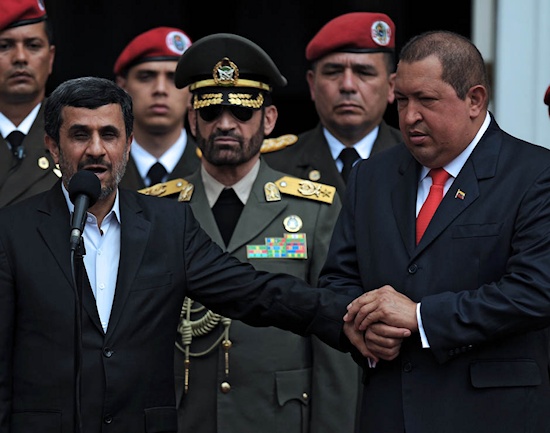
Venezuelan President Hugo Chavez (R) holds the hand of his Iranian counterpart Mahmoud Ahmadinejad (L) as he spaks during his visit to Miraflores presidential palace in Caracas on January 9, 2012. (Photo: JUAN BARRETO/AFP/Getty Images)
Iran’s increased activity in Latin America is part of its global strategy, whose objectives go far beyond the desire for hegemony in the Middle East. Iran, regarding itself as hemmed in by the United States and its allies, stubbornly pursues the nuclear crisis with the West and seeks to present the United States with a revolutionary challenge in its own backyard by exploiting its relative advantages with countries and populaces in Latin American: Iran’s anti-American ideology and rhetoric, which fall on receptive ears; Iranian petrodollars, which can be used for political and propaganda purposes; and a large Muslim population, some of it Lebanese, living in key Latin American countries.
Iran’s interests and objectives in Latin America are the following:
1) Politics and strategy: Iran has found ideological and political sympathy in a number of Latin American countries, which may enable it to escape from its increasing political isolation and strengthen the so-called “resistance camp” it leads (including Syria, Hezbollah, and Palestinian terrorist organizations). Iran also regards Latin America as a good area for defiance and for challenging the United States through increased political and military collaboration, economic infiltration and extensive activities to disseminate Shi’ite Islam and eventually export the Islamic Revolution to Latin America.
2) Economics: Iran focuses on economic relations with Latin American countries in energy and oil, and strives to increase those relations to help it circumvent the sanctions which have been imposed on it. Thus Iran’s relations with Venezuela enable it to coordinate prices with a large oil exporter like itself (Iran and Venezuela are respectively the fourth and fifth largest oil exporters in the world). In addition, Iran wants to exploit uranium deposits in Venezuela and other Latin American countries (in 2009 Venezuela publicly stated that Iran was helping it explore for uranium.) However, Iranian-Latin American economic collaboration is still limited and a relatively small factor in Iran’s overall trade.
3) Harming Israel’s political relations with Latin America countries: One example was the terminating of Israeli-Venezuelan and Israeli-Bolivian relations during Operation Cast Lead. In addition, Iran’s close relations with Venezuela and other countries create an internal political atmosphere and even infrastructure (encouraged by Iranian propaganda) to harm the Jewish communities in those countries (where, as in other parts of the world, often no distinction is made between anti-Israel policy and harming Jewish communities).

"Get out," graffiti on the wall of a synagogue in Caracas, Venezuela's capital. (Photo by Carlos Garcia Rawlins for Reuters, January 31, 2009)
4) Constructing secret intelligence and terrorist networks: Those networks give Iran operational-terrorist options, using the Quds Force and other bodies, to launch terrorist activities against Israel and the United States, both routinely and as the order of the day. Iran exploits the subversive and terrorist capabilities of Hezbollah, which conducts extensive activity in Latin America and has increased its presence there while engaging in drug-trafficking and other crimes.
Limitations of Iran’s Political Power in Latin America
Ahmadinejad’s last visit to Venezuela (January 9, 2012) and other Latin American countries (Nicaragua, Cuba and Ecuador) illustrated that regardless of Iranian aspirations in Latin America there were limitations to its political power. His visit was prompted by the increasing tension between Tehran and the West and Iran’s growing international isolation. One of his objectives in visiting Latin America was to demonstrate Tehran’s ability to advance its relations with countries beyond the borders of the Middle East and in a region considered America’s backyard, and show it could defy, and perhaps even threaten, the United States. However, in reality, Ahmadinejad and the Latin American countries did not sign new agreements, and his visit was accompanied by broad criticism from local media for Iran’s not having honored previous economic commitments.
The considerable efforts made by Iran to strengthen its ties with other important Latin American countries, beyond those where it has already gained a foothold thanks to its relations with Venezuela, were unsuccessful. For example, Iran’s relations with Argentina, virtually destroyed after the two terrorist attacks on the Israeli embassy and the AMIA Jewish community center in the early 1990s, have never been repaired (the attacks are still a cause of tension in the Argentinean arena). In May 2011, Bolivia forced Vahidi, Iran’s minister of defense, to cut short a state visit following political pressure from Argentina. Brazil has distanced itself from Iran since Dilma Rousseff was elected president, and Iran’s relations with Colombia and Mexico are strained (both of which accuse Iran of promoting drug-trafficking and terrorism within their borders). In addition, Iran’s broad activity in Latin America has so far not significantly damaged Israeli-Latin American relations (with the exception of Venezuela).
Iranian-Venezuelan Relations
Since Ahmadinejad was elected president in August 2005, Iran had strengthened its relations with revolutionary Latin American countries which defy the United States and object to its regional influence. Ahmadinejad’s vision, ambitious as it is, to lead the world camp opposing American hegemony and create a new (Islamic) world order, and his determination to export the ideology of the Islamic Revolution, found a willing disciple in the form of Hugo Chávez, Venezuela’s president. Iranian strategy was also integrated into political, societal and economic changes both in Venezuela and in other countries. Chávez, whose policies are defiantly anti-American, succeeded in marketing Iran to other Latin American countries, among them Nicaragua, Ecuador and Cuba.
In recent years political and economic cooperation between Venezuela and Iran has increased significantly. They signed many agreements regarding their economies, banks, oil and natural gas. Military relations were strengthened after a military delegation headed by Iran’s minister of defense, Mostafa Muhammad Najjar visited Caracas (April 30, 2009). The two countries signed a memorandum of understanding intended to strengthen joint military collaboration.
Political and economic collaboration between the two countries were manifested in two specific fields:
1) Exploring for and mining uranium: The Carnegie Endowment for International Peace issued a report in December 2008 on possible Iranian-Venezuelan collaboration in mining Venezuelan uranium. According to the report, Venezuela is estimated to have 50,000 tons of unmined uranium and might mine it for Iran.[3] According to an article in The Guardian, Iran was helping Venezuela look for uranium using geophysical flights and geochemical deposit analysis. The article stated that uranium had been found in western Venezuela and the southeastern Bolivar state.[4]
2) Banking and financial services: In 2009 it was reported that Iranians had opened an international development bank in Venezuela called the Banco Internacional de Desarrollo. It is an independent subsidiary of Iran’s Export Development Bank. In 2008 the United States Treasury Department imposed sanctions on both banks for having provided or attempted to provide financial services to the Iranian ministry of defense and Armed Force Logistics, both Iranian entities which promote Iran’s nuclear program.[5]
Ambassador Roger Noriega, formerly a diplomat with the American State Department and today a fellow of the American Enterprise Institute (AEI), said in testimony before the American Senate Foreign Relations Committee in February 2012 that Iran had provided Venezuela with weapons systems. He said the systems gave Hugo Chávez, Venezuela’s president, unprecedented capabilities to threaten Venezuela’s neighbors, and indirectly to threaten the United States[6] (See below for further details about Noriega’s testimony).
The Iranian Battle for Hearts and Minds
Several million Arabs and Muslims live in Latin America, most of them Sunnis (with a Lebanese Shi’ite minority), and are the principle target of Iran’s propaganda activities. There are two main communities: one whose roots are in India, Indonesia and Pakistan, and the other, made up mainly of Arabs from Syria and Lebanon, descendents of immigrants who moved to Latin America in the 19th and 20th centuries. While the percentages of the Arab-Muslim populations in each country are not statistically significant, their socio-economic status is relatively high.
The two largest Arab-Muslim communities in Latin America are in Brazil and Argentina. There are about a million to a million and a half Muslims in Brazil, including about 10,000 Brazilians who converted to Islam (less than 1% of the entire population). About 700,000 Muslims live in Argentina (about 2% of the population), most of them descendents of immigrants from Syria and Lebanon.[7] Large concentrations of Muslims can also be found in Chile, Paraguay, Peru, Venezuela, Mexico and the Caribbean Islands.
The Muslims spread throughout Latin America, especially Shi’ite Muslims originating in Lebanon, provide a convenient environment for Iran and Hezbollah for establishing subversive, terrorist and occasionally criminal networks. Iran also conducts extensive ideological, religious, cultural and social activities within the Muslim communities to disseminate Khomeini’s radical Shi’ite Islam. The activities are often interrelated (See below).
Iran’s intensive efforts to export the Islamic Revolution to Latin America take many forms: financing the construction of mosques and cultural and religious centers; translating books and ideological and religious material into Spanish and distributing them throughout Latin America; providing local residents with religious and political training in Iran (who then return to their own countries imbued with radical Islam and anti-American, anti-Israeli ideology); sending Iranian clerics to preach Khomeini’s ideology in Latin America; and establishing a Spanish TV station which broadcasts 24/7 (HispanTV, which began broadcasting on February 1, 2012);[8] and providing assistance in establishing Spanish-language Internet sites.

HispanTV, Iran's Spanish-language TV station: "strengthening relations with Latin America is currently Iran's number one priority."
Subversion and Terrorism
In the overall Iranian view, Latin America is a secondary arena. Its principle venues for widespread subversion and terrorism are Iraq, Syria, Lebanon, the Palestinian arena, Central and Southeast Asia, the Persian Gulf and Sudan. Nevertheless, Iran and Hezbollah find Latin America attractive for purposes of terrorism, subversion and crime. As elsewhere, in Latin America their activities are led by the Quds Force in collaboration with various other bodies and entities within the Iranian regime.
Iranian activity in Latin America, as in other arenas, combines exporting the Islamic Revolution with terrorism and crime, worries Washington and is often represented as a threat — or at least a potential threat — to American interests. However, specialists, officials in the administration and Congressmen who monitor Iranian and Hezbollah activity in Latin America sometimes differ as to how serious they think the threat and its significance are.
In our opinion, there is a methodological difficulty in assessing the nature and seriousness of the Iranian threat because it is not easy to distinguish between Iran’s vast subversive activities and those undertaken to export the Islamic Revolution, on the one hand, and its terrorist activities on the other: On the one hand, experience has taught that subversive and propaganda activity (with the addition of criminal activity) prepare the ground for a network of people who are liable, given the right circumstances, to participate in terrorist activity. On the other, Iran’s preoccupation with disseminating Shi’ite Islam and exporting the Islamic Revolution to Latin America may not necessarily be translated only into terrorist activity, but has the potential to endanger other American interests in Latin America (such as fostering hatred for the United States and the radicalization of the Latin American Muslim population).
On January 5, 2012, the American Congressional Research Service (CRS) issued a study called “Latin America: Terrorism Issues,” written by Mark Sullivan, a specialist in Latin American affairs.[9] It quoted the State Department’s Country Report on Terrorism (published in August 2011), which stated that “There are no known operational cells of either Al-Qaeda or Hezbollah-related groups in the [western] hemisphere.” However, according to the Report, “ideological sympathizers in South America and the Caribbean continued to provide financial and moral support to these and other terrorist groups in the Middle East and South Asia.”
Other Latin American experts in the United States, however, give greater importance to the threats to American interests, including the threat of terrorism, resulting from Iran and Hezbollah’s extensive activities in Latin America. One of them is Ambassador Roger F. Noriega, who testified many times before Congressional committees. Familiar with Latin American affairs, between 2003 and 2005 he was the American ambassador to the Organization of American States and today is a fellow of the American Enterprise Institute (AEI) and one of a team of experts monitoring Iranian activity in Latin America.
On February 16, 2012 a hearing was held by the Senate Foreign Relations Subcommittee to discuss Iran’s influence and activity in Latin America. Ambassador Noriega presented the subcommittee with the results of his team’s research, which dealt with threats to the United States caused by Iranian activity in Latin America. “Our exhaustive work,” he said, “leads to the following conclusions:”[10]
- “Venezuelan strongman Hugo Chaves and Iranian leader Mahmoud Ahmadinejad are conspiring to wage an asymmetrical struggle against U.S. security and to abet Iran’s illicit nuclear program. Their clandestine activities pose a clear and present danger to regional peace and security.
- Iran has provided Venezuela conventional weapon systems capable of attacking the United States and our allies in the region.
- Iran has used 30$ billion in economic ventures in Venezuela as means to launder money and evade international financial sanctions.
- Since 2005, Iran has found uranium in Venezuela, Ecuador and other countries in the region and is conducting suspicious mining operations in some uranium-rich areas.
- Two terrorist networks one home-grown Venezuelan clan and another cultivated by Mohsen Rabbani, a notorious agent of the Qods Force of the Iranian Revolutionary Guards Corps, proselytize, fund-raise, recruit, and train operatives on behalf of Iran and Hezbollah in many countries in the Americas.
- Hezbollah conspires with drug-trafficking networks in South America as a means of raising resources and sharing tactics.
- The Venezuelan state-owned airline, Conviasa, operates regular service from Caracas to Damascus and Teheran — providing Iran, Hezbollah, and associated narco-traffickers a surreptitious means to move personnel, weapons, contraband and other materiel.
Iran’s activities in Latin America and its readiness to carry out terrorist attacks on American soil (manifested by the attempted assassination in Washington of the Saudi Arabian ambassador) led Ambassador Noriega to the conclusion that “Tehran’s activities near our homeland constitute a very real threat that can no longer be ignored.” Despite with the grave assessments of the Iranian threat as expressed in a number of expert testimonies before Congress, certain members of the American administration are of the opinion that Iran’s influence in Latin America is limited and that the United States can minimize it.
Investigating How Iran and Hezbollah Operate in Latin America
The following study deals with Iranian and Hezbollah activities in Latin America in three interrelated areas:
- Section I — Terrorism: Latin America as an arena for Iranian-Hezbollah terrorism.
- Section II — Criminal activities: Iranian and Hezbollah involvement in criminal activities which serve as a source of revenue and and also serve their subversive and terrorist activities in Latin America.
- Section III — Subversion and exporting the Islamic Revolution: Exporting radical Islam and Shi’a, and fostering hatred for the United States and its allies (including Israel) in Latin America as part of Iran’s global strategy.
![]()
Notes:
[1] Follow-up of the ITIC April 19, 2009 study “Iran increases its political and economic presence in Latin America, defying the United States and attempting to undermine American hegemony”.
[2] According to Ambassador Roger F. Noriega before the US Senate, February 16, 2012. See below.
[4] The Guardian, Sept 26, 2009.
[5] Online.wsj.com, September 8, 2009.
[6] In November 2010 and May 2011 the German daily newspaper Die Welt reported that Venezuela and Iran had signed an agreement for the joint operation of a missile base in Venezuela. In response the American State Department said that it had not evidence to support Die Welt’s report.
[7] Based on Lieutenant-Colonel Curtis C. Connell, [US Air Force] Air University, Cadre Paper No. 21, “Understanding Islam and Its Impact on Latin America,” Air University Press, March 2005.
[8] Mohammad Hosseini, Iran’s minister of culture and Islamic guidance, referred to the establishing of HispanTV as a step meant to fill Iran’s needs in Latin America. He said that “strengthening relations with Latin America is currently Iran’s number one priority…Iran wants to increase its presence in that area of the world” (ilna.ir website).



 RSS
RSS

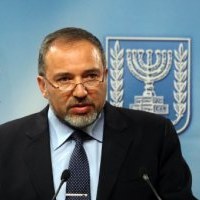

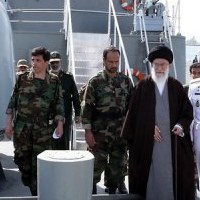
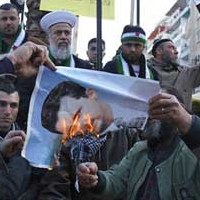
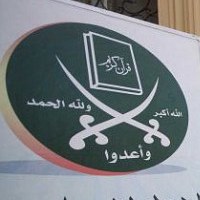




[…] section is part of the study dealing with Iranian and Hezbollah activities in Latin America. The other two sections can be found […]
[…] section is part of the study dealing with Iranian and Hezbollah activities in Latin America. The other two sections can be found […]
[…] published by the Gatestone Institute. Read also: “Latin America as an Arena for Iran and Hezbollah’s Terrorist, Subversive and Criminal Activiti…“. Subcomandante Marcos of Chiapas entered into an alliance with a Muslim movement in the […]